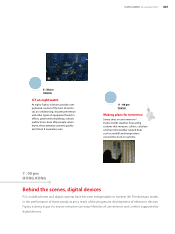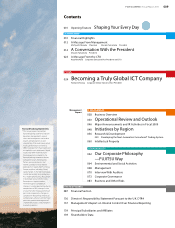Fujitsu 2010 Annual Report Download - page 19
Download and view the complete annual report
Please find page 19 of the 2010 Fujitsu annual report below. You can navigate through the pages in the report by either clicking on the pages listed below, or by using the keyword search tool below to find specific information within the annual report.
Overview of Fiscal 2009
Q.2
Q.3
A.2
A.3
Please discuss Fujitsu’s new executive management structure.
What is your assessment of business performance for fiscal 2009, ended March 31, 2010?
We opted for a system in which five corporate senior executive vice presidents and two
corporate executive vice presidents assist me in the management of Fujitsu. The five corpo-
rate senior executive vice presidents are each responsible for a specific business area. This
fact notwithstanding, I have also told them to establish alliances beyond their own
assigned domains to create new vertically integrated*1 businesses.
Despite a sales decline in our solutions business, we managed to clear our initial operating
income targets by making sweeping reductions in costs and expenses across Fujitsu. Our
ongoing structural reforms also yielded benefits, resulting in a more robust financial position.
We began operating under this new management structure in April 2010. In concrete terms, the five corporate senior
executive vice presidents and two corporate executive vice presidents assist me as president under this system. My role
in management execution is to provide leadership. Each corporate senior executive vice president is personally respon-
sible for one of five areas—global business, ICT services business, industry solutions, products, and corporate affairs.
However, I have instructed them to constantly consider management of the whole company in all of their actions.
For new vertically integrated business models like cloud computing, alliances between business areas are more
vital than ever before. The ICT industry is expected to see drastic changes, as well as more intense global competi-
tion. Accordingly, the corporate senior executive vice presidents have been instructed to develop close partnerships
that transcend their respective domains. The aim here is to parlay alliances between Fujitsu operations into the
generation of new businesses. While I am ultimately responsible for any final decisions, I think we now have a system
for business execution that facilitates rapid decision-making.
The two corporate executive vice presidents serve as the CFO*2 and CSO*3, respectively. The functions that the
CFO and CSO perform are essential to Fujitsu’s management, since both roles effectively support myself and the five
corporate senior executive vice presidents.
Fiscal 2009 started off in an economic climate deeply shaded by the lingering shock of Lehman Brothers’s collapse.
Taking stock of the situation, we declared an operating income target of ¥90 billion and sought to address a variety
of issues. Looking back over the year, the ICT market has definitely struggled to regain its footing. However, we
strove to cut costs and expenses across Fujitsu. In the end, we managed to clear our initial objective, as operating
income rose ¥25.6 billion year-on-year,
to ¥94.3 billion.
We also remain intensely commit-
ted to structural reforms. For me, struc-
tural reforms can be understood as a
means of changing one’s present busi-
ness model into something new. In
fiscal 2009, we completed the transfer of
the hard-disk drive (HDD) business,
which had been a lingering issue. The
LSI business has also shifted to a fab-
*1 Vertically integrated
business model:
A business model in
which Fujitsu serves as
a one-stop provider of
hardware, software, and
services solutions.
*2 CFO:
Chief Financial Officer
*3 CSO:
Chief Strategy Officer
017
FUJITSU LIMITED Annual Report 2010
A Conversation With the President
























